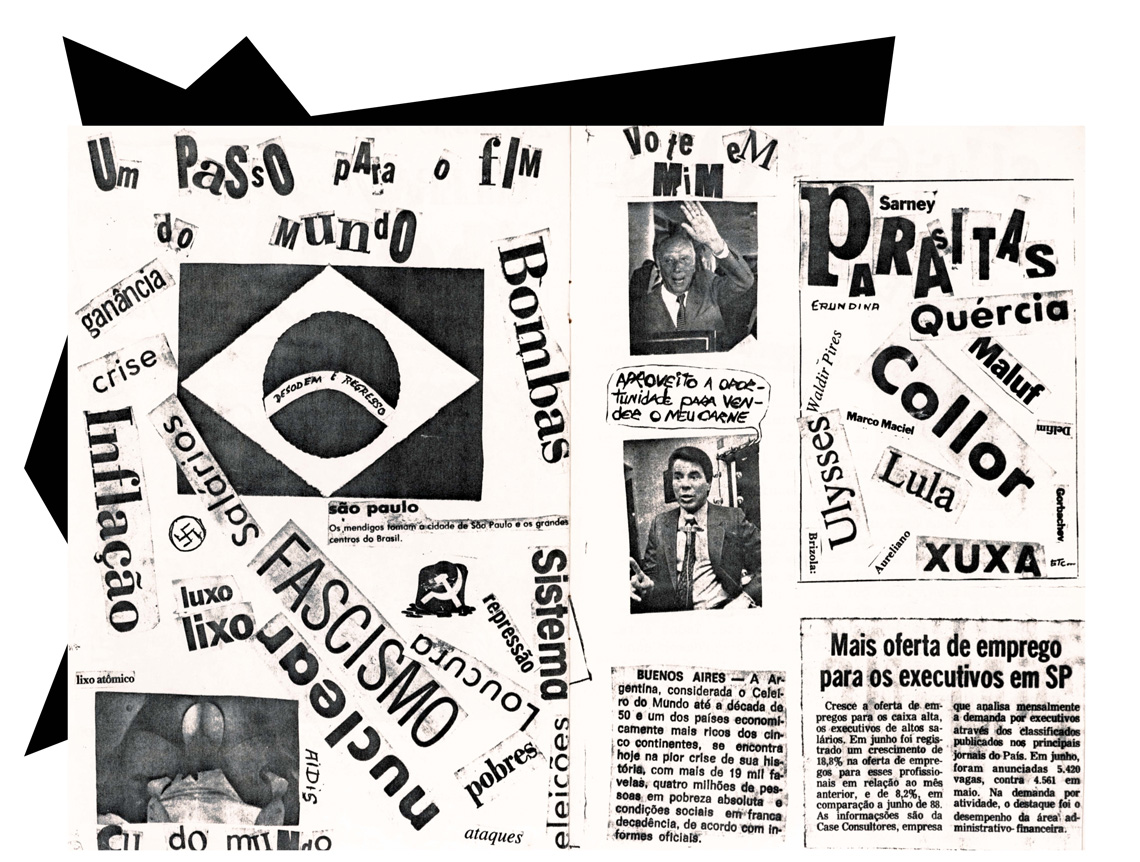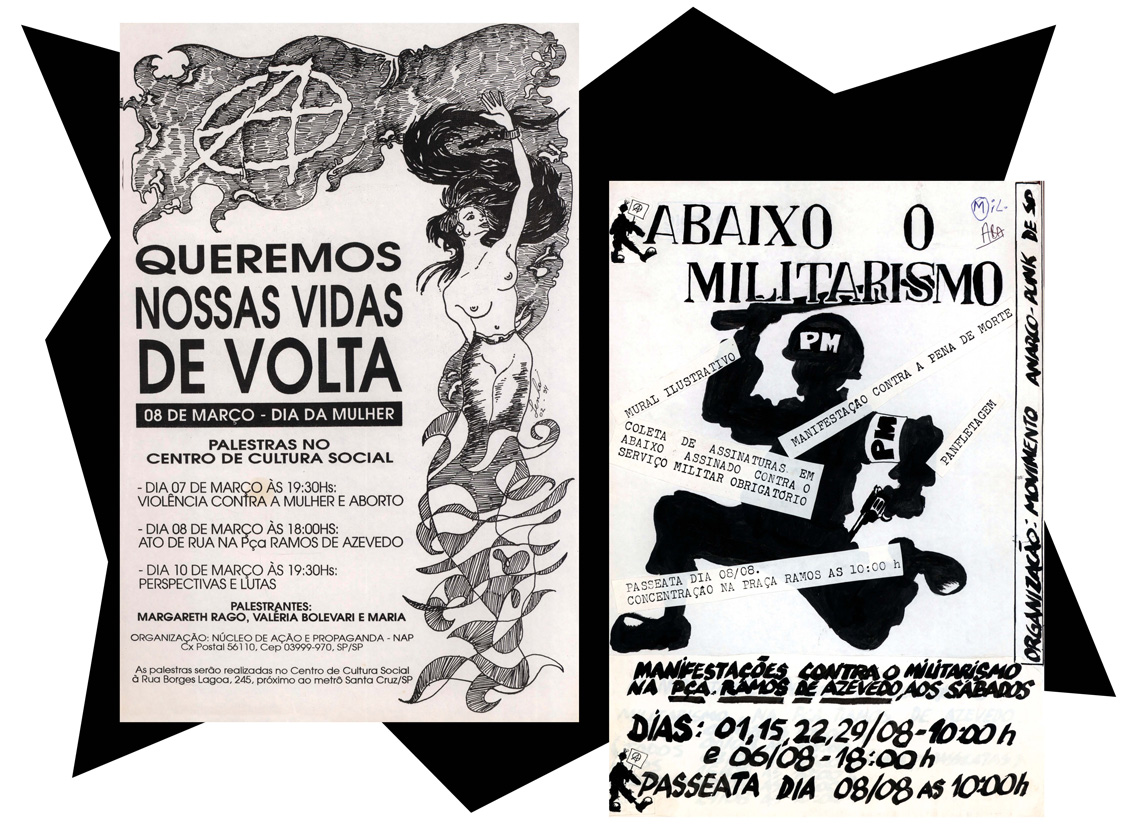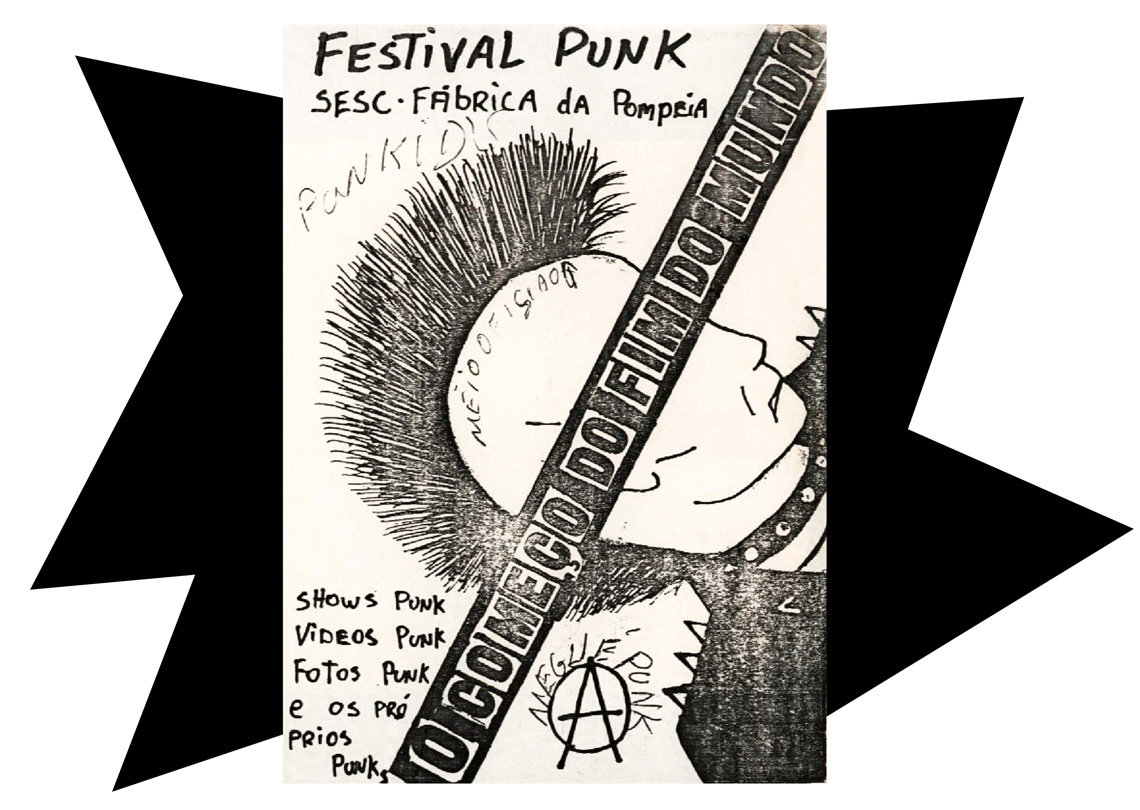They were times of economic crisis and political transition. In the 1970s, the high employment and strong social welfare system that characterized the post-war period lost traction in many countries around the world. Young people saw their prospects for the future waning, and rock music, the genre that had signified youthful rebellion since the 1950s, was transformed as a result. The beat of the drums accelerated and the distorted guitar chords were simplified to accompany the aggressive chanting of the lyrics. Its fans were spread across major cities and their suburbs: groups of young people with eye-catching hairstyles who called themselves punks, a word that was originally slang for “worthless.”
Brazil was suffering the throes of the military dictatorship (1964–1985) when young adults and teenagers first heard and saw the music and style of the punks. Some of the first Brazilian fans of the genre were the children of diplomats living in Brasília. The bands that were formed in the federal capital at the time went on to influence the sound of Brazilian rock music throughout the 1980s. One was Aborto Elétrico (1978–1982), with Renato Russo (1960–1996) on vocals and Fê Lemos on drums, who later formed the bands Legião Urbana and Capital Inicial respectively.
At the same time as punk was arriving in Brazil, so was the specialized media, which covered new bands on the international scene. An important milestone in punk’s consolidation in the minds of Brazilian teenagers was a 1977 edition of the magazine Pop, published by Abril, which included an article about the new style, accompanied by a mixtape of songs by bands such as the Sex Pistols and the Ramones. The cassette tape, with which it was possible to record and copy music from record players and radios, was essential to the dissemination of the genre among teenagers.

Acervo Punk1983 issue of the comic strip Lixo reciclado; and the fanzine C.D.N Conservação da natureza (undated)Acervo Punk
Despite mostly only involving young people and lacking any organized ambition, the punk movement produced a vast written record of its activities and ideas in the 1980s. The primary choice of media was fanzines. In these homemade publications, written with typewriters or by hand and with illustrations cut out from newspapers and magazines, members of the scene discussed not only their favorite bands but also the themes that preoccupied young people at the time, from discovering their sexuality in the midst of the AIDS epidemic to the threat of nuclear war.
Many such documents were preserved thanks to the efforts of Antônio Carlos de Oliveira, a historian from São Paulo who in 1979, at the age of 14, immersed himself in punk. Over the following decades he accumulated a huge collection not only of fanzines but also posters, concert programs, and other documents related to the movement. In addition to the collection itself, which he gathered over 20 years, the historian corresponded with other people involved in the punk scene since the formation of the first bands at the end of the 1970s. His collection was boosted by material donated by people leaving the scene. “People who left punk to join anarchism and those who moved toward Nazism both gave me an immense volume of documents,” says Oliveira, author of books such as Punk: Memória, história e cultura (Punk: Memory, history and culture; Rizoma, 2015).
The material, stored in 48 boxes, comprises the Movimento Punk collection, the primary source of research for studies on the scene in Brazil. Originally kept at the Social Cultural Center (CCS), an association run by the anarchist movement in São Paulo, the approximately 10,000 documents were transferred to the Center for Documentation and Scientific Information at the Pontifical Catholic University of São Paulo (CEDIC-PUC-SP) in the early 2000s, where they remain to this day. The collection was one of the main sources for historian João Augusto Neves Pires’s PhD thesis, which he defended this year at the Institute of Philosophy and Human Sciences of the University of Campinas (IFCH-UNICAMP). During his research, which was funded by FAPESP, Neves spent two years studying Oliveira’s collection. “The idea was to trace the connections between the documents. To discover, for example, that a letter in box 10 referred to a show whose poster was in box 15,” explains the historian.

Acervo PunkPosters for the First Meeting of the Punk Bands of São Paulo (undated), and the Second Anti-Nuclear Meeting (1987) in RecifeAcervo Punk
The process helped Neves profile the movement’s fans in the São Paulo Metropolitan Region in the 1980s for his thesis. “The documentation shows that these young people, branded troublemakers by the media, were not alienated and held a firm political position. There are many defenses for spoiling the ballot. Some of the publications even followed the topics being discussed in the National Constituent Assembly [1987–1988],” reports the researcher. Another element that captured his attention was the social network created by the scene in an analog world, before the dawn of the internet. “Punk bands from São Paulo corresponded with the global punk movement, in addition to getting involved in activities and shows in towns in the state’s interior or in other regions of the country.” One example of this form of networking was described in the March 1983 edition of the fanzine Maximum Rock’n’Roll, published in San Francisco, USA, which highlighted the Brazilian punk scene, especially in São Paulo.
The study, which explores the early years of punk in São Paulo with resources from urban history, the history of sensibilities, and the history of music, reveals the power of a phenomenon with countless derivations. In the documentation left by the fans, as well as in the media from the time, police records, and censorship archives, there are accounts from a vast array of sources, from the anarchism that attracted Oliveira and gave rise to anarcho-punk to the ultranationalism of groups like Carecas do ABC, which gradually move toward ideas of white supremacy. Other modern movements of a political nature are also laying claim to the concept of punk, such as the straight edge movement, which advocates for veganism, abstinence from alcohol, and the rejection of sexual promiscuity. “The unifying element of this diversity is the simplicity of the music, characterized by the use of few instruments—usually just a guitar, bass, drums, and vocals,” explains Neves. “This minimalist aesthetic is perfect for expressing the sense of revolution that characterizes punk.”
Although the term “punk” is now well established, there is no defined way of accounting for all of its complexities. There are points in common, of course, such as the nonconformism and “DIY” approach that explains so much of the punk aesthetic: hand-drawn t-shirts, bands formed by people with no musical training, improvised props based on everyday objects. “There is no way to define the movement,” highlights Tiago de Jesus Vieira, a historian from the State University of Goiás (UEG) who studied the subject for his master’s degree and PhD, which he defended at the Federal University of Mato Grosso (UFMT). “Punk tends to attract fans through music and behavior, with a vague idea of revolution. From there, the idea interplays with what really bothers young people in their lives and thus assumes the characteristics of their environment.”

Acervo PunkA fanzine from 1989, untitledAcervo Punk
Since the mid-2000s, the Movimento Punk collection has been gradually digitized by Oliveira, who is now a teacher in the public school system. During his PhD research, Neves also digitized some of the documents he used in his studies. This material can now be accessed via Acervo Punk, a virtual archive created by Neves to share the documents and sources he collected throughout the study.
In Brazil, the punk scene has rarely been studied in academia, say UEG’s Vieira and anthropologist João Batista de Menezes Bittencourt of the Federal University of Alagoas (UFAL). Last year, the two researchers published an article in which they attempted to identify all of the literature on the subject published in the country over the last four decades. According to their survey, which made use of the Dissertations and Theses Database of the Brazilian Federal Agency for Support and Evaluation of Graduate Education (CAPES), the first master’s dissertation to address the topic in Brazil was “Movimento punk na cidade: Invasão dos bandos sub” (Punk in the city: Invasion of the sub bands), defended in 1985 by Janice Caiafa of the Social Anthropology Graduate Program at the National Museum of the Federal University of Rio de Janeiro (UFRJ).
A few years prior, in 1982, playwright and journalist Antonio Bivar (1939–2020) published O que é o punk? (What is punk?), which has become a renowned work on the subject in Brazil. Bivar was introduced to the scene when he lived in the UK in the 1970s. He was one of the organizers of the festival O Começo do Fim do Mundo (The Beginning of the End of the World), held at SESC Pompeia in São Paulo in 1982 and considered a milestone in the history of Brazilian punk. The event, which attracted around 3,000 people, featured performances by bands such as Ratos de Porão, Inocentes, and Cólera.

Acervo PunkFlyers for International Women’s Day (1994) and antimilitary (undated) events in São Paulo, organized by anarchists and punksAcervo Punk
According to the survey by the pair of researchers, there were just four master’s dissertations and one doctoral thesis written on punk in Brazil between 1982 and 2000. Things began to change, however, in the twenty-first century. Between 2001 and 2020, 54 academic papers were written—45 master’s dissertations and nine doctoral theses. “Over the years, the subjects have diversified,” points out Vieira. “Recent works are following aspects of the movement linked to gender, such as Riot Grrrl, which denounces sexism within punk, and queercore, which is related to LGBT+ issues.”
Bittencourt agrees. “Contemporary punk is more open to intersectional themes, such as feminism, LGBT+, and antiracism. And this is reflected in the surveys. The literature on the movement shows that it used to involve a lot of machismo, homophobia, and racism, especially in the first generations of Brazilian punks, but these issues have been problematized by researchers in recent years,” says the anthropologist, who coordinates the Punk Scholars Network (PSN) in Brazil, an international network of researchers that has around 40 members in the country, most linked to Brazilian universities.
Although the survey shows that most of the academic production on the subject was written in the Southeast, it also reveals that studies on the subject have begun to spread across the country since 2001. “Much is said about the role of São Paulo and Brasília in the Brazilian punk scene, but these works show that even in the late 1970s there were punk collectives in several cities nationwide, such as João Pessoa, Fortaleza, Salvador, and Natal,” says Bittencourt. “These studies provide new perspectives and help to add more nuance to the history of punk in Brazil.”
Project
Noises in the fragmented metropolis: Punk performances and resentment in São Paulo (1978–1988) (nº 17/18962-4) Grant Mechanism Doctoral (PhD) Fellowship Supervisor Josianne Francia Cerasoli (UNICAMP); Beneficiary João Augusto Neves Pires; Investment R$239,105.49.
Scientific article
BITTENCOURT, J. B. M. & VIEIRA, T. J. 40 anos de pesquisas sobre o punk no Brasil: Novas possibilidades em cena. Anos 90. Revista do Programa de Pós-graduação em História da Universidade Federal do Rio Grande do Sul. vol. 29. 2022.
